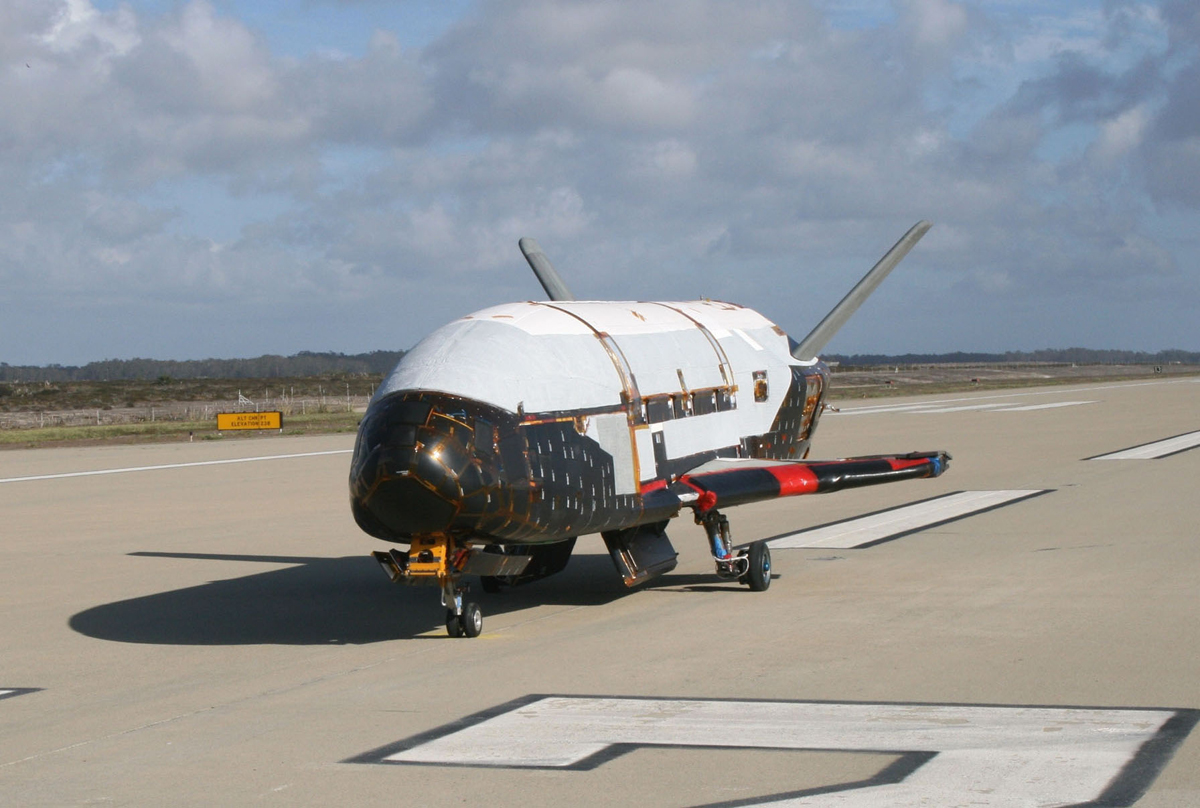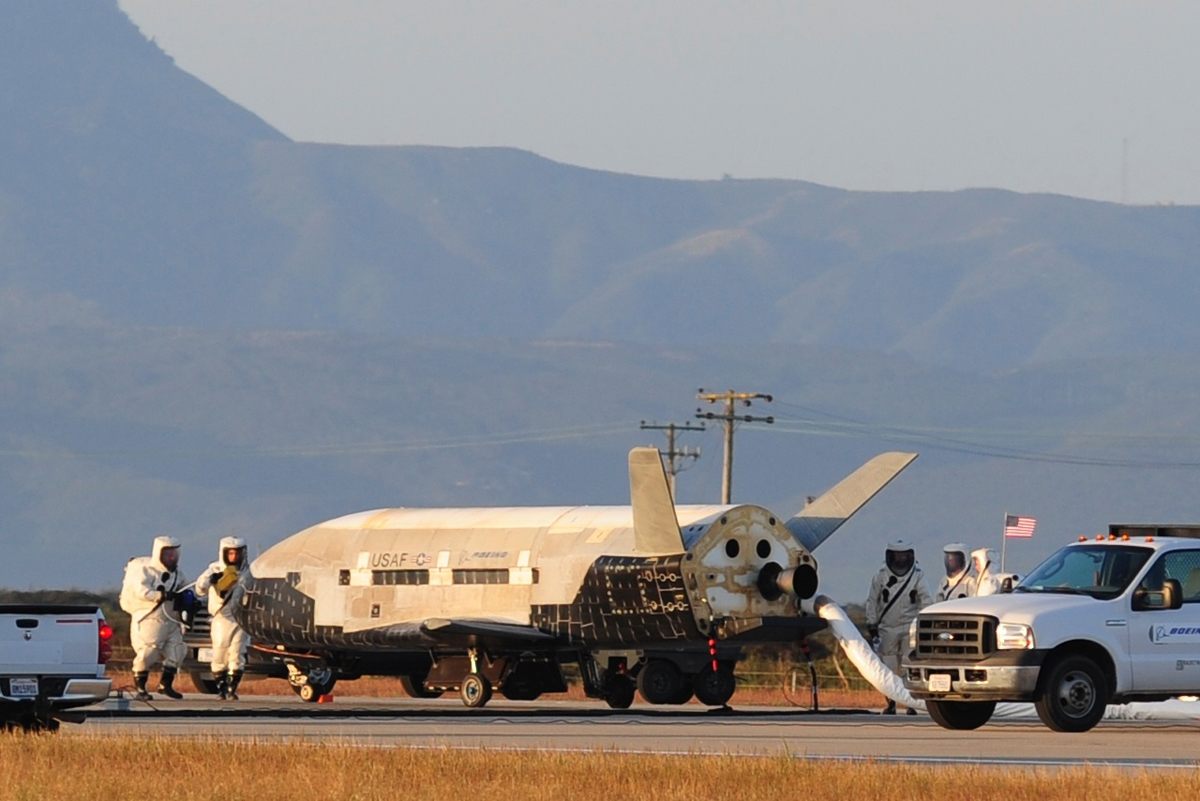Secretive Air Force Space Plane's Purpose Questioned


When the wheels of the second Air Force X-37B Orbital Test Vehicle came to a stop on the tarmac at Vandenberg Air Force Base in California a few weeks ago, the true military utility of this enigmatic, robotic spacecraft remained as hush-hush as the classified payload it carried.
After circuiting Earth for 469 days and then winging its way down from space over the Pacific Ocean, the petite autopiloted craft glided back into a cocoon of secrecy.
An 11,000-pound (5,000 kilograms) state-of-the-art vehicle, the X-37B is about a fourth the size of NASA's space shuttle orbiters.
Built by Boeing Government Space Systems, the second flight of the X-37B – labeled Orbital Test Vehicle-2 (OTV-2) — "tested additional capabilities," said Paul Rusnock, Boeing vice president of Government Space Systems.
OTV-2 eclipsed the nearly 225-day mission duration of the first vehicle, as well as the vehicle's 270-day baseline design specifications. [Photos: Air Force's 2nd Secret X-37B Mission]
Later this year, the same craft that flew the OTV-1 mission is to roar into orbit atop an Atlas 5 booster on a refurbished, repeat voyage. Once again, its workload is classified.
So what do we know aboutthe rationale for the X-37B project?
Breaking space news, the latest updates on rocket launches, skywatching events and more!
Repeatedly reused
"We look forward to the second launch of OTV-1 later this year and the opportunity to demonstrate that the X-37B is an affordable space vehicle that can be repeatedly reused," said Rusnock in a Boeing press statement.
Just as tight-lipped about the program as its military customer, Boeing does view the X-37B as innovative and combining "the best of an aircraft and a spacecraft into an affordable, responsive unmanned vehicle."
Last year at Space 2011, a conference organized by the American Institute of Aeronautics and Astronautics (AIAA), an X-37B derivatives plan was sketched out by Arthur Grantz, chief engineer in the Experimental Systems Group at Boeing Space and Intelligence Systems in Seal Beach, Calif.
Grantz detailed a vision for the spacecraft to support space station cargo deliveries and for a scaled-up version to carry astronauts into orbit.
The X-37B program is managed by the U.S. Air Force Rapid Capabilities Office and the vehicle is built to showcase risk reduction, experimentation and concept of operations development for reusable space vehicle technologies.
"With the retirement of the space shuttle fleet, the X-37B OTV program brings a singular capability to space technology development," said Lt. Col. Tom McIntyre, X-37B program manager. "The return capability allows the Air Force to test new technologies without the same risk commitment faced by other programs."
McIntyre has stated that the X-37B's heat-thwarting advanced thermal protection and on-orbit solar power systems, as well as environmental modeling and range safety technologies are just some of the things being tested. "Each mission helps us continue to advance the state-of-the-art in these areas," he said in an Air Force press statement.
Implications for the future
So how did this last flight of the X-37B fare on its 15-month stealthy sojourn?
Mum's the word from Boeing due to it being a classified program.
Pentagon spokesperson for the X-37 project, Air Force Major Tracy Bunko, said post-mission assessments on the second orbital test vehicle are progressing.
"But it's premature to discuss any results or findings at this time. Our next, third, mission is on track for October 2012, pending final launch assignment and range scheduling," Bunko said.
While inquiring minds may want to know what's next for X-37B, military and space analysts contacted by SPACE.com remain perplexed. [US Air Force's Secretive X-37B Space Plane (Infographic)]
Institutional momentum
"I haven't a clue," said John Pike, director of Globalsecurity.org. This program has been around for over a decade, he said, and has had multiple sponsors and multiple nominal missions as well as multiple suspected/attributed missions.
"Those who say don't know. And those who know don't say," Pike said. "Part of the story is just blind institutional momentum, the imperative to get the program funded and the jobs saved."
Pike's email calling card carries the tag line: "Vision without funding is called hallucinating."
Regarding the X-37B, Pike said, at this point, he thinks the main "purpose" of the effort is to keep Chinese military intelligence officials guessing "since they will have to respond to everything it might be."
Economic sense?
Somewhat similar in view is Yousaf Butt, a scientific consultant to the Federation of American Scientists.
"I am not aware of anything this spacecraft can do that couldn't be done cheaper with a disposable [spacecraft] bus. I believe the ongoing project is indicative of institutional inertia," Butt said. "Just like the space shuttle never made economic sense, neither does X-37B. However, it is merely an experimental program so may not need to justify itself on economics."
Similarly in the dark about the purpose of the X-37 initiative is Steven Aftergood, director of the Project on Government Secrecy at the Federation of American Scientists in Washington, D.C.
"Since I really don't know what the program is all about, I am reluctant to speculate," Aftergood said. "I would like to believe that it represents a thrilling technological breakthrough, brilliantly executed with profound national security benefits. But who knows?"
Valet parking
"I don't see great significance in the X-37B," said Laura Grego, senior scientist for the Global Security Program at the Union of Concerned Scientists. "I would be surprised to see the project continue in this budget-constrained environment."
Grego told SPACE.com that describing the X-37B as a "spaceplane" encourages people to think of it as a spacecraft that can maneuver on orbit to visit satellites or target the ground more effectively.
"But it doesn't do those things well. It isn't going to be efficient at maneuvering in orbit because all the landing gear and re-entry shielding it carries makes it heavy," Grego said. "Neither is it a satellite launcher like the space shuttle, and it doesn't launch satellites more cheaply or more quickly."
In Grego's view, what the X-37B seems to be optimized for is carrying cargo, but not people, up to space and back down with a nice, graceful runway landing.
"Since capsules have been returned from space for decades via parachutes, one might fairly think of the X-37B as really expensive valet parking," Grego concluded.
Distinctive duty
"Space planes like the X-37B are clearly not cost-effective or operationally advantageous as platforms for launching satellites or space weapons, when compared with conventional upper stage buses without wings, heat tiles and landing gear," said Mark Gubrud, a proponent of space arms control and adjunct assistant professor in the department of physics and astronomy at the University of North Carolina, Chapel Hill.
Still, the winged minishuttle does have a distinctive duty.
"One unique capability is to carry a payload back to a particular base on Earth. This may be useful for testing and development of space hardware, if direct inspection of the returned payload yields more information than telemetry alone," Gubrud said. "But even here, the economics are dubious in comparison with capsules and parachutes."
Space planes may also have the ability to modify their orbit with the aid of aerodynamics, skimming in and out of Earth's atmosphere, Gubrud added, "but that stressing capability does not seem to have been tested, and its value in practice is also dubious."
Since the technical, economic and tactical case for the X-37B is so weak, Gubrud concluded, it seems likely that the program benefits from perceptions — among politicians, bureaucrats, military brass and the public — that it is cool, futuristic technology.
"It keeps alive the ambitions symbolized by the space shuttle, in that it has more capability and promise than it actually does. This may also account for the efforts of other nations to copy the program, despite the inability of anyone to explain its rationale," Gubrud said.
Test driving
"Given that the X-37 stayed in Earth orbit longer than the original 'specs' for the vehicle, it appears that the Air Force is trying to push the edges of the envelope in terms of what the vehicle itself can do," said Joan Johnson-Freese, professor of National Security Affairs at the Naval War College in Newport, R. I.
That's not surprising since the vehicle is a testbed for prototype technology, such as what kind of sensors are most useful, Johnson-Freese said.
Lately, Johnson-Freese said that she's often discussed China's Shenzhou 9 docking with the unmanned Tiangong module, and mused over what the purpose of that spacecraft is.
"It seems to me that both Tiangong and the X-37 are just what their owners say they are, and that is, technology testbeds," Johnson-Freese said. From operational, scientific and engineering perspectives, she said, it makes sense.
"Sometimes you have to try new technology out and see what it can do before you can assign it a specific role, or use the knowledge gained to refine it or develop something else," said Johnson-Freese.
Often in the military, something is not built unless it has a specific mission before it's even developed. For example, Johnson-Freese said, the Global Positioning System (GPS) was almost cancelled because its specific "mission" was said not specific enough before development. "And what a loss that would have been," she said.
"So I think it's actually very good that the military is 'test driving' this new vehicle now, rather than later. Another mission in October will likely be to test other parameters," Johnson-Freese concluded.
Leonard David has been reporting on the space industry for more than five decades. He is a winner of last year's National Space Club Press Award and a past editor-in-chief of the National Space Society's Ad Astra and Space World magazines. He has written for SPACE.com since 1999.

Leonard David is an award-winning space journalist who has been reporting on space activities for more than 50 years. Currently writing as Space.com's Space Insider Columnist among his other projects, Leonard has authored numerous books on space exploration, Mars missions and more, with his latest being "Moon Rush: The New Space Race" published in 2019 by National Geographic. He also wrote "Mars: Our Future on the Red Planet" released in 2016 by National Geographic. Leonard has served as a correspondent for SpaceNews, Scientific American and Aerospace America for the AIAA. He has received many awards, including the first Ordway Award for Sustained Excellence in Spaceflight History in 2015 at the AAS Wernher von Braun Memorial Symposium. You can find out Leonard's latest project at his website and on Twitter.


